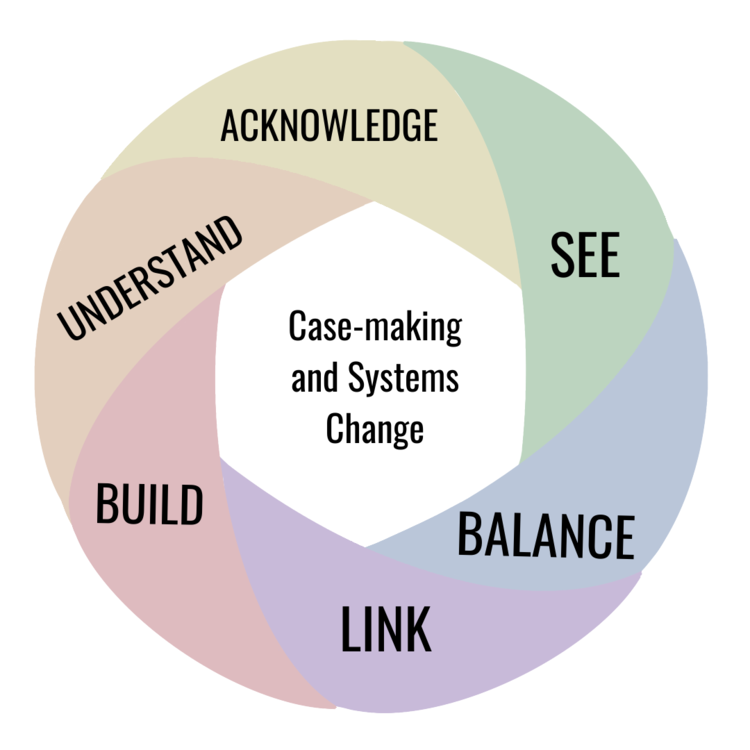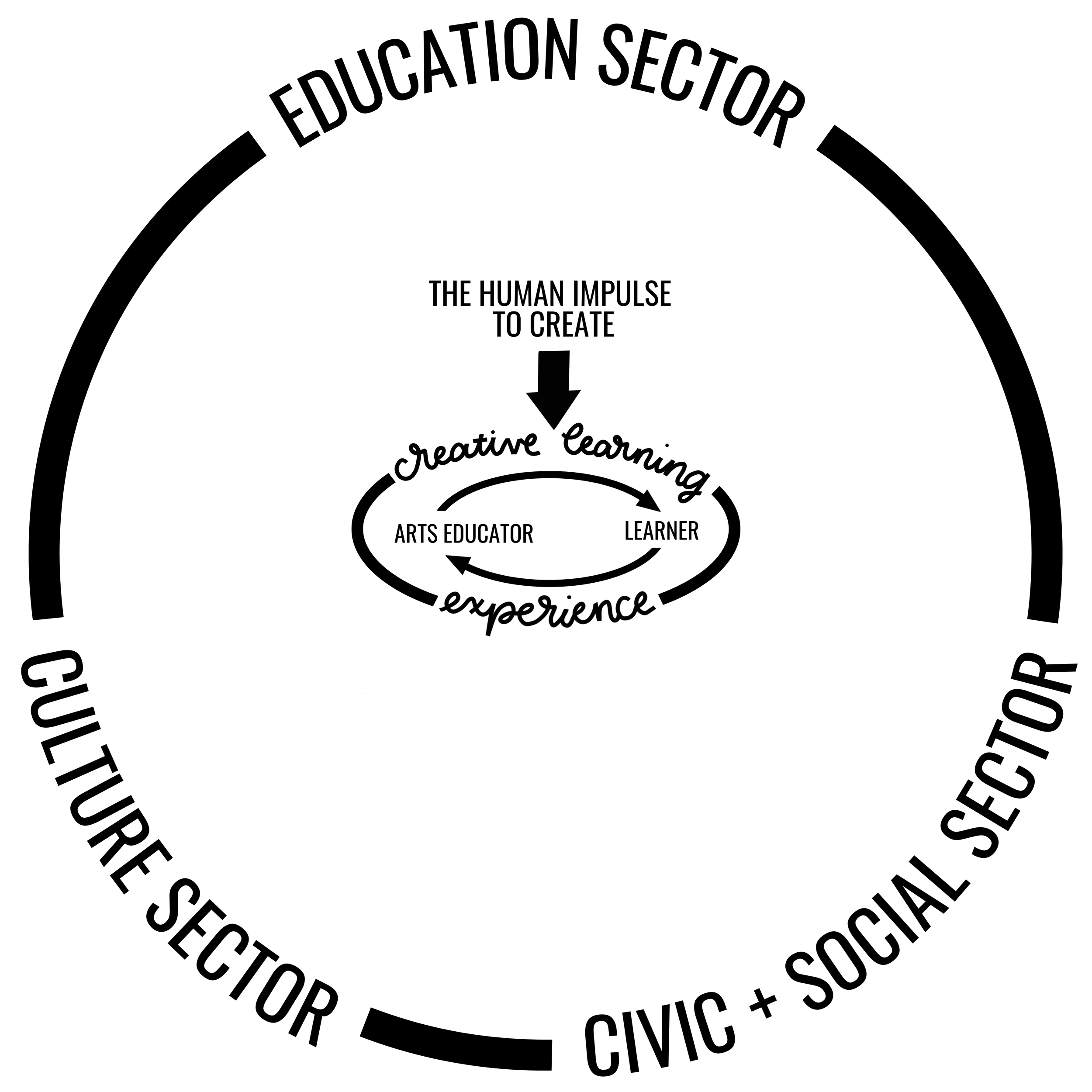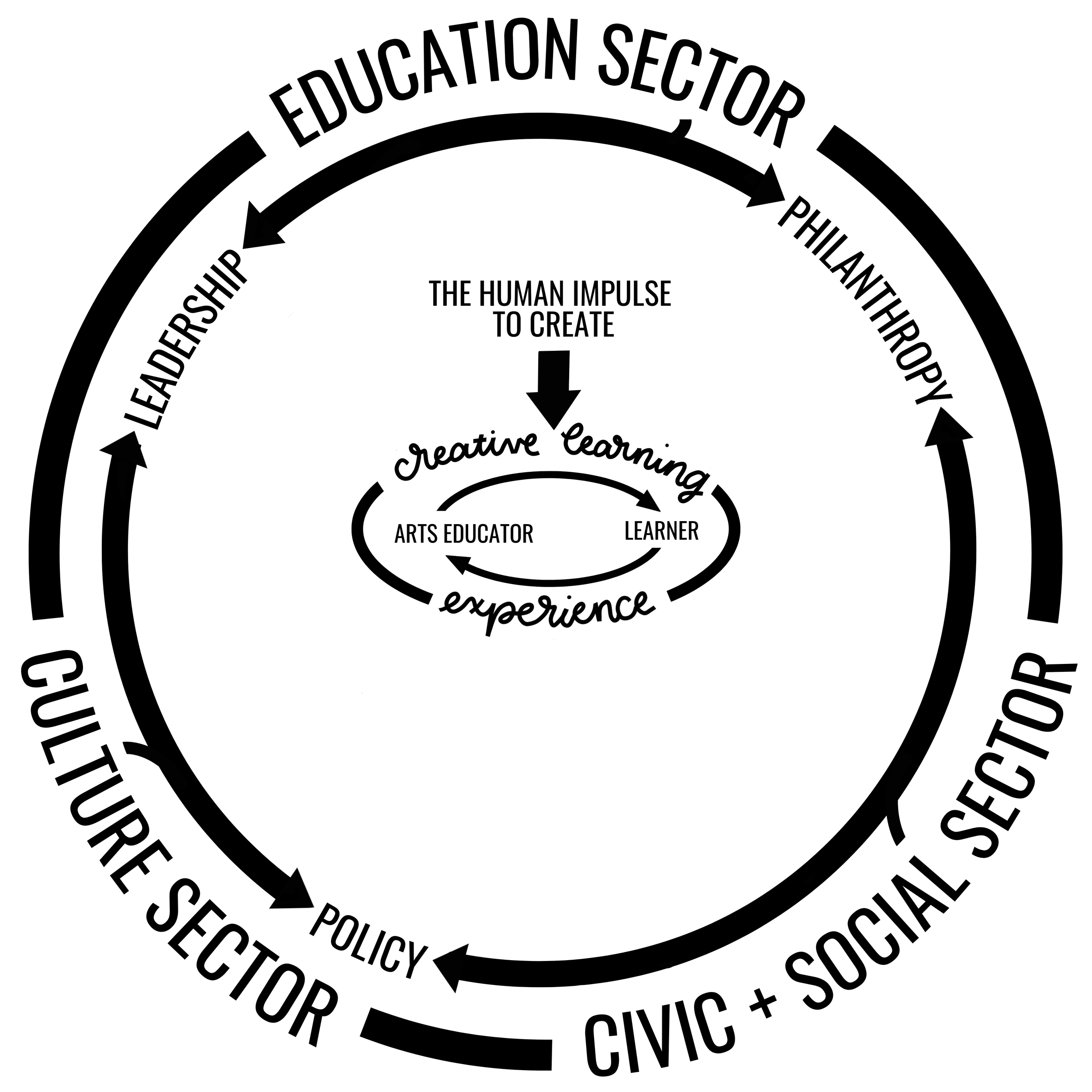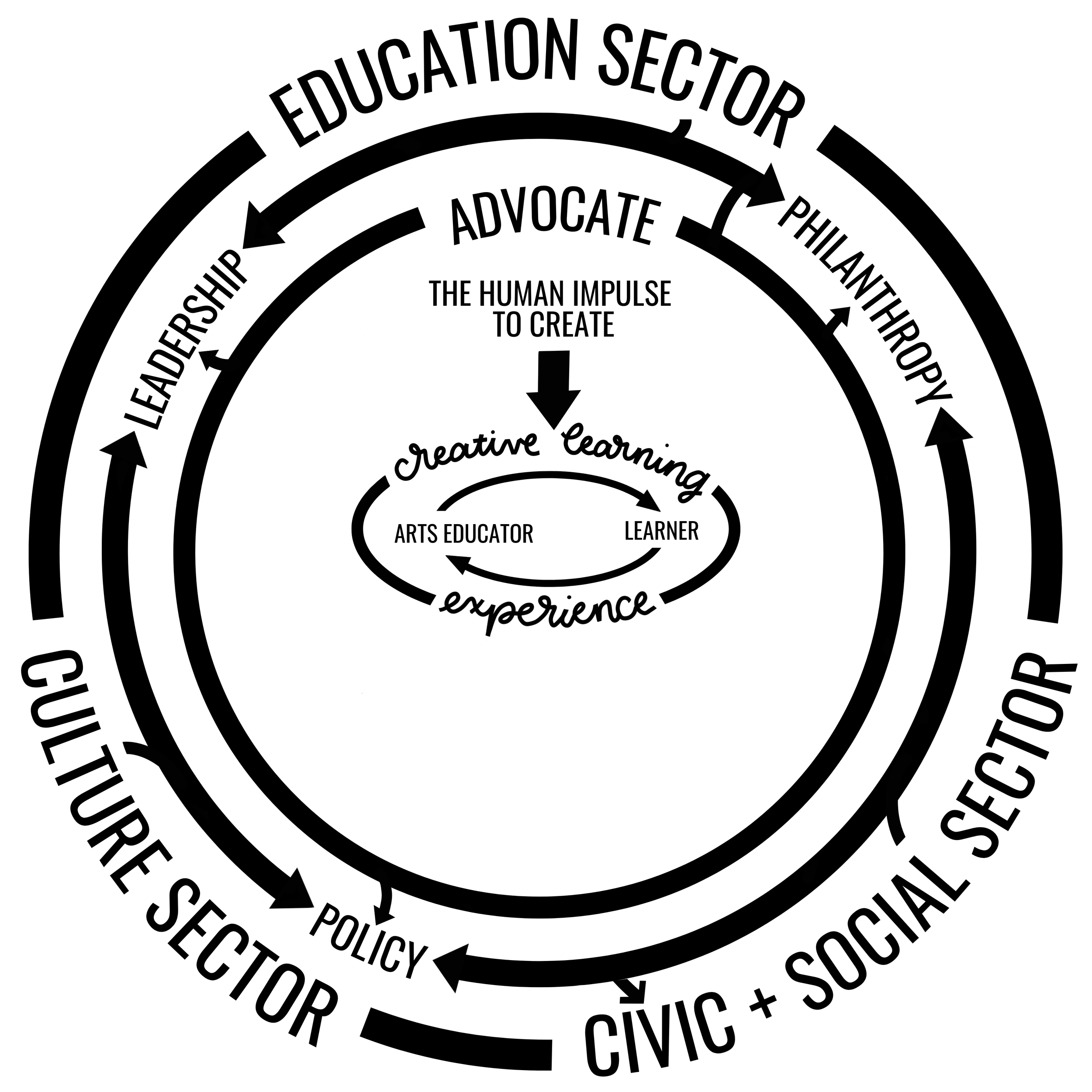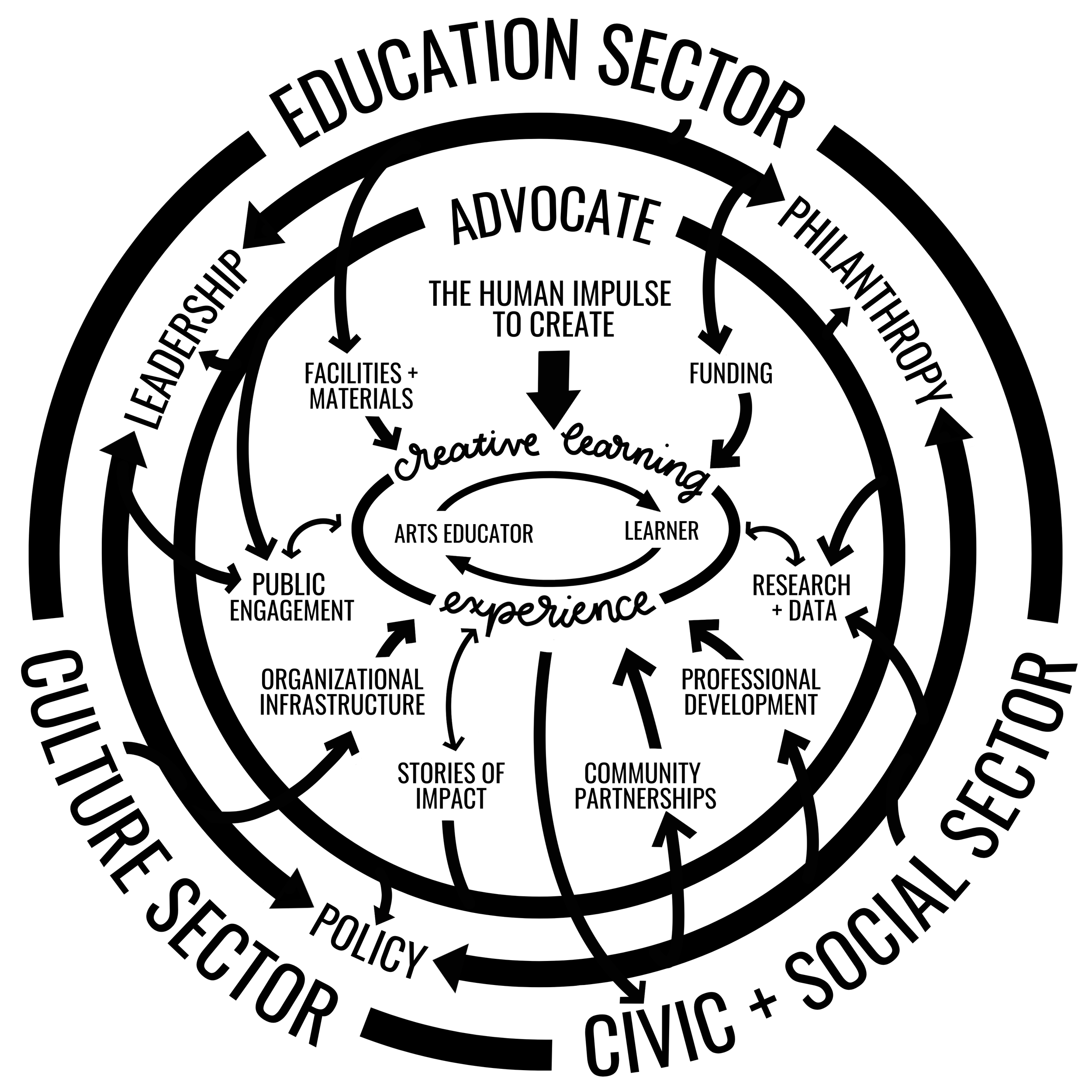By: Laurie T. Schell
Systems thinking* is often defined as a discipline for seeing wholes rather than parts, acknowledging interconnections among components, and understanding dynamic behavior among parts of the system. As it relates to arts education, the larger system is the education sector itself, where the interplay of policy, practice, and longstanding cultural norms come face to face with the realities of budget constraints and community values.
In this fifth article in the series Case-making and Systems Change in Arts and Cultural Education, I expand on the theme of Advocacy for the Sector, describing how history has shaped the system of arts education, with a review of the components of our current system.
This article proposes a new systems model of arts and cultural education in an attempt to understand the sectors, influence, supports, and drivers of change. Please note: I recognize that creative learning happens both inside and outside of the school day; I also recognize that most of the public policies which have historically inhibited arts and cultural education are K-12, formal education policies, thus this model specifically looks at systems change regarding K-12 arts education in a formal education setting.
In the introductory article in this series, I shared the below model which encapsulates the variety of lenses representing key concepts which emerge from the research. As practitioners, we may view these as guideposts to enhance our experience and effectiveness as advocates.
See the larger system and work within a local context
Balance organizational structure and flexibility
Link communications strategies to goals
Build adaptive processes that encourage engagement
Understand the dynamics of systems change
Acknowledge progress at all levels
Historical Context
Arts education in public schools exists in a complex system that is unlike other subject areas. Even though the arts remained one of the core academic subjects, when high stakes testing was introduced with 2001 No Child Left Behind Act (NCLB), many schools placed greater emphasis and resources on the tested subjects, such as reading and math. In many school districts, maintaining viable arts programs required a complex support system of non-school sources such as private philanthropy, teaching artists, and nonprofit arts organizations. School districts with limited funding were faced with a tough decision based on scarce resources between tested subjects (reading/math) and non-tested subjects, including the arts. Too often, districts with high per pupil spending could “afford” the arts, while those with low per pupil spending were forced to narrow the curriculum in favor of tested subjects. This created greater gaps between wealthy and poor districts, and greater disparities in access to the arts, often with differences between schools within the same district.
The 2015 Every Student Succeeds Act (ESSA) marked a victory with the inclusion of music and the arts as part of an expanded definition of “well rounded education.” It also brought a greater emphasis on local control, giving school districts and schools much greater autonomy over what is taught – and it eliminated the previous emphasis on testing.
NCLB and ESSA have given rise to efforts to close the access gap with public value campaigns, research on the benefits of the arts in education, community partnerships, and targeted advocacy and lobbying, all in an attempt to influence public opinion and policy at the local, state, and national levels. In this article, we look at understanding the complex arts education system and identifying levers that lead to change.
The arts education landscape, or ecosystem, is well described in the Arts Education Field Guide from Americans for the Arts. It is depicted as concentric circles of stakeholders, each with responsibility and accountability, with the students holding center stage.
In response to the increased collaboration among arts and academic disciplines – through a pedagogical approach called arts integration – and community arts organizations, the nonprofit Young Audiences produced “Arts Education for America’s Students: A Shared Endeavor,” which articulates the unique role and contribution of each in service of a holistic arts education.
In the Declaration of Equity in Music for City Students from Yale University, “ecosystem is a network of interacting individuals, communities, and systems in which diverse elements are balanced and thrive. A music ecosystem, then, is the network of music-making people, places, and systems that characterize a city’s music and cultural life.”
Components of Systems Thinking
Creative Learning at the Core
The human impulse to create is the force that drives creative learning. It is the overarching societal outcome that drives the model. From the earliest cave paintings to TikTok videos, humans express their humanity in creative ways. Creative Learning Experiences are the heart of the model. Arts Educators and Youth are the lifeblood of creative learning, where the magic of teaching and learning happen. Creative Learning Experiences are supported by three sectors — Education, Cultural, and Civic + Social. It is the interaction and engagement of these sectors that offer opportunities for advocates to make an impact.
Centers of Influence
Within the three sectors are centers of influence that impact creative learning experiences:
Policy: Local, state, and national policies influence both what is taught in the public schools and budgetary allocations.
Leadership: School board members, school administrators, and elected officials influence the provision of creative learning through policies, procedures, and financial support.
Philanthropy: Foundations, corporations, and individuals influence creative learning experiences through outright and leveraged gifts.
Drivers of Change
Advocates (That includes ALL of you!) hold a very special place in the systems map. It is important to note that directional arrows in the map travel both ways. Ultimately, the Centers of Influence– Policy, Leadership, and Philanthropy– are influenced by and influence the desired outcomes.
Advocates– be they practitioner, field builder, or policy advocates-- are the drivers of change. They utilize Public Engagement and Research/Data to generate stories of impact that will in turn influence (and are influenced by) Policy, Philanthropy, and Leadership.
Areas of Impact
Centers of influence support creative learning in one or more Areas of Impact:
Funding for any of the areas listed below.
Research and Data that provide baseline data and highlights possible inequities.
Professional Development to ensure quality teaching.
Community Partnerships that enrich and enhance school programs.
Organizational Infrastructure such as dedicated staffing, to support educators and students.
Public Engagement such as public will campaigns, to amplify the value and benefits.
Facilities and Materials to provide adequate instructional materials, equipment, and facilities that serve all youth.
See Yourself in the System
We describe the system so that we can change it.
We can be effective change agents regardless of where we are on the systems map.
Guiding questions to get started:
As an Advocate, with which areas are you most closely aligned?
Sector (Education, Cultural, Civic + Community)
Center of Influence (Leadership, Philanthropy, Policy)
Area of Impact (Funding, Research/Data, Professional Development, Community Partnerships, Organizational Infrastructure, Public Engagement, Facilities/Materials)
As an Advocate, what is your preferred Driver of Change method (advocacy actions) that will lead to influence and improved Creative Learning outcomes?
Public Engagement
Research
Stories of Impact
As you review the systems map, identify people in your community who fill roles in the Centers of Influence? Who is active in the Areas of Impact? Who are the community partners? Funders? Research partners? Policy experts? Education decision makers?
What do you want to accomplish? How will you collaborate across Centers of Influence and Areas of Impact? How will you reach out to others in your community to influence change? For example, an educator might collaborate with a researcher to better communicate the impact of the arts on student learning. A policy expert might provide a briefing to school board members that sheds light on an issue of inequality.
There is no magic formula for systems change. Systems change work is iterative; it can start from anywhere within the system. It is dynamic and fluid, with actions, influence, and outcomes moving in multiple directions.
That’s it. Thanks for wading through the theory to get to some essential truths. Start from where you are. Build relationships outside your bubble. Know what your goals are. Adapt as needed. Okay, go.
*Systems thinking is a practice that recognizes interconnections, identifies and understands feedback, understands how system structures facilitate behavior, acknowledges the variability and flow of assets (such as funding or leadership), and understands dynamic behavior (Arnold, 2015, pp 676-679).
This article was adapted by the author from “Communications for Cause”on ElevateArtsEd.
Your comments, observations, and suggestions are welcome. Thank you for your interest and your commitment to this important work.
-
Schell, L. T. (2022, August 17). Systems Change in Arts Education. Creative Generation Blog. Creative Generation. Retrieved from https://www.creative-generation.org/blogs/systems-change-in-arts-education

